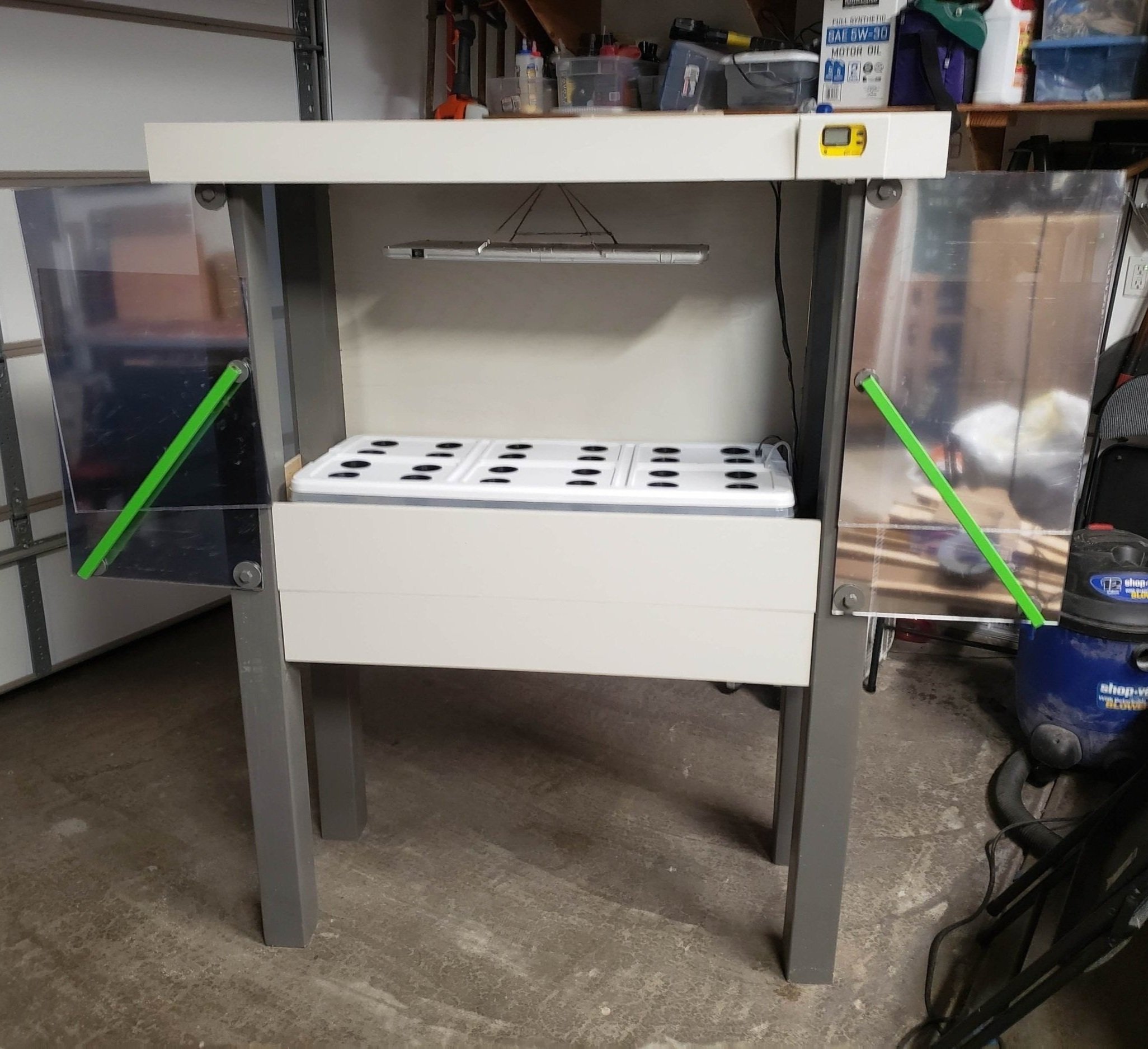Square Root
A semi-automated hydroponics system
Summer 2021
3 month project
I love to garden, but in the Pacific Northwest the growing season is short. This prevented me from growing warm climate plants such as hot peppers. To solve this problem, I started researching hydroponics.
This is the third generation of my hydroponics system. The other systems involved variations in medium, light, and hydroponics system.
The first was a deep water culture with red and blue LED lighting. This system grew plants very well but the lights were hard to look at which led me to cover up the system so I would not have to look at it. It also sat very close to the ground which made it tedious to maintain.
The second system was a flood and drain with florescent light tubes. The lights were much nicer to look at, however they did not last as long as the LED lights. It also had an automatic timer and a ph monitor which made maintaining much easier. The flood and drain method was not as efficient as the deep water culture. The flood and drain method did not deliver as much nutrients and it was more work to refill the water basin.
The third system incorporates all of the benefits and automations that I learned from the previous systems. This resulted in a system that is automated, efficient, and astatically appealing.
Hydroponics provides a controlled environment for plant growth, resulting in increased yields and faster growth rates. it also allows for year-round growing of a variety of plants.
It takes up less space compared to traditional soil-based farming methods, making it ideal for urban and indoor farming.
The use of hydroponics reduces the need for pesticides and herbicides, providing a safer growing environment for both plants and humans.
It conserves water by recirculating the nutrient solution and minimizing water waste.
Design Goal
Create a semi-automated and space efficient hydroponics system.
Ideation and Materials
Technology Layout
Mood Board
Door Movement






Construction
Final Product
Research
-
Tinted windows that reflect light back into the enclosure. ph and temperature sensors to monitor the status of the nutrient solution. Timed lights that simulate the day and night cycle. An interior hight of two feet with adjustable hight grow light. A drawer for storing tools, nutrient solutions, and equipment. Aerator to circulate water and prevent root rot.
-
Deep Water Culture (DWC): Plants are suspended in a nutrient-rich water solution with their roots submerged. An air pump provides oxygen to the roots.
Nutrient Film Technique (NFT): A shallow stream of nutrient-rich water is continuously circulated over the roots of plants growing in a trough.
Flood and Drain (Ebb and Flow): The growing tray is flooded with nutrient-rich water and then drained, simulating the natural cycle of a soil-based system.
Aeroponics: The roots of plants are misted with a nutrient-rich water solution, providing them with a constant supply of oxygen and nutrients.
-
Rockwool: A popular medium for hydroponics, rockwool is made from melted basalt rock and is a good choice for growing plants that prefer a well-draining growing medium.
Coco coir: A sustainable alternative to rockwool, coco coir is made from coconut husks and is known for its good water retention and air flow properties.
Aeroponics: In aeroponic systems, roots are misted with a nutrient solution, eliminating the need for a growing medium altogether.
-
Plants growing in a hydroponic system need the same essential nutrients as plants growing in soil, but in different forms. The three primary macro nutrients that plants need are nitrogen (N), phosphorus (P), and potassium (K). Other important macro nutrients include calcium (Ca), sulfur (S), magnesium (Mg), and iron (Fe).
If the pH is too low or too high, it can affect the plant’s ability to absorb nutrients, leading to stunted growth, yellowing leaves, or even death.
-
In general, it is recommended to use full-spectrum light. This will provide all the light that plants need for healthy growth. The two light waves that plants absorb the most are red and blue.
During the vegetative stage, blue light (wavelength of 400-500 nm) is important for promoting strong stem and leaf growth. During the flowering stage, red light (wavelength of 600-700 nm) is important for promoting flower and fruit development.
Using red and blue lights exclusively is slightly more efficient, however it is not as visually appealing.




























